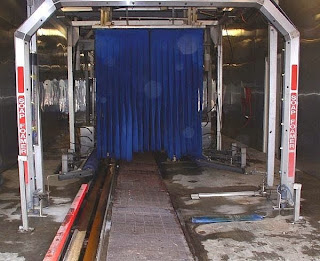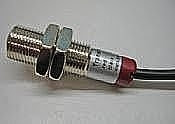The first thing to consider when choosing a sensor for an automatic car wash is the type of application that the sensor will be used in. Photoelectric sensor systems typically consist of, at very least, an infrared transmitter, an infrared receiver, and in high-powered systems, an external amplifier. For the simple detection of a vehicle, the photo eyes are positioned on either side of the car wash. The transmitter photo eye emits an infrared beam of light across the bay that is detected by the receiver photo eye. When the infrared beam is interrupted by a vehicle, a signal is sent to the equipment to perform the desired application. This may be starting the equipment, measuring or profiling the vehicle, or simply opening and closing the doors. Usually, one sensor is mounted high, while the other is mounted low so that the sensors form a diagonal line to the ground. This causes the beam to pass through the area where the largest portion of the vehicle will pass and helps to reduce false signals. Mechanical treadle plates that are used to position the vehicle may be replaced by photoelectric sensing systems.
The body of the sensor should be durable and designed to withstand the harsh conditions of the wash. There are sensor bodies available in plastic, nickel-plated brass, and stainless-steel to meet the requirements of the car wash environment. A simple infrared sensor like the ones used in a residential garage door application are not designed to withstand the conditions in a car wash and should be avoided in this type of application because they lack the proper sealing. For the car wash environment select a sensor with an IP67 rating. This rating is used to inform the end-user that the sensor is sealed in a way that will not allow the internal circuits to be damaged by water spray or submersion. The range of the sensor is important for two reasons. It is much easier to mount the sensors in a place where they will not be hit if they have a long enough sensing distance. A strong infrared beam will also assist in penetrating the steam, mist, and soap that are present while the wash is running and will provide fewer false signals and the resulting down-time.
Required maintenance to photoelectric sensors is easy, and requires very little time. Check the alignment of the photo eyes using a length of string or wire long enough to pull in a line between the sensors. This line should be parallel with the sides of both sensors. If you are using a set of photoelectric sensors that uses an external amplifier, periodically check to be sure that the seal on the enclosure box is still intact and that no water has penetrated into the inside of the box.
If you have problems with the photoelectric controls, determine the nature of the problem. Are they giving an intermittent output that flickers? Do the sensors report an output all the time? Is it impossible to break the beam between the photo eyes? Once you determine the nature of the problem, it is then easier to isolate the cause. If there is a flickering output, check the alignment of the photo eyes. Next check to be sure the photoelectric system is turned high enough. (On amplified systems, this setting is located on the amplifier, inside the water-tight enclosure.) If both of these things appear normal, check for corrosion at any points where the cable has been cut and spliced. If you find corrosion, be sure to cut and reconnect the wires using a soldered connection and heat-shrink tubing. This will help seal out moisture from the connection. If you still see flickering from the output of the photo eyes, check to be sure all wires that should be grounded are connected to ground. The wires from the photoelectric controls should not share the same conduit as the wires from any motor controls.
If a constant output is the problem, check both photo eyes for obstructions. Be sure trash hasn't blown in front of the eyes and found a permanent home in the path of the beam. Alignment may also be an issue, but if they are out of alignment far enough to give a solid output signal, then this should be fairly obvious to the naked eye. Next, look closely at the face of the photo eyes. Check for visible cracks or bad abrasions. Even an IP67 sealed photo eye can be rendered useless if a large enough crack forms in the face of the sensor, thereby allowing moisture to breach the internal circuits of the photo eyes.
If it appears that the infrared beam between the eyes is impossible to break, the cause is one of several things. The first is simply that the intensity of the infrared beam is too strong and that it is literally not being blocked as the vehicle passes. Reflections on the wet walls contribute to this problem also. Try turning the strength of the system down a little. If this doesn't work, check the alignment of the photo eyes. Maybe the photo eyes see each other at an angle and when the vehicle passes through, the beam is not being broken at that angle.
Related products and information
Infrared photoelectric sensors for car washes
Infrared photoelectric amplifier for use with photoelectric sensors




Hi. I really enjoyed my brief visit on your site and I’ll be sure to be back for more.
ReplyDeleteCan I contact your through your email?
Please email me back.
Thanks!
Kevin
kevincollins1012 gmail.com